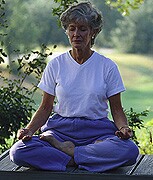HealthDay Reporter
MONDAY, Sept. 15 (HealthDay News) -- A new large global survey reveals that more than half of women who suffer from osteoporosis do not perceive themselves to be at a higher risk for experiencing a fracture.
The international team of researchers noted that this apparent lack of concern about the potential for developing a debilitating or even life-threatening fracture flies in the face of estimates that suggest that one in two women over the age of 50 will ultimately go on to experience an osteoporosis-related fracture in their lifetime.
"It's very frustrating," said study co-author Dr. Ethel S. Siris, a professor of clinical medicine in the division of endocrinology at Columbia University Medical Center in New York City. "Despite the fact that awareness of osteoporosis itself has increased lately, many of these women just don't get it. Not just in the U.S., but all over the world. Either because we haven't gotten the message across adequately, or because people simply do not want to hear it."
"But the fact is," she added, "that fracture risk goes way up among women with osteoporosis, and fracturing your vertebrae or hip, for example, is a very serious business. So, women simply need more education about it, not because we want to frighten them but because we want to empower them. Because the good news is, there are things -- lifestyle choices, medications -- that one can do to lower risk."
Siris and her colleagues were expected to present their findings Monday at the American Society for Bone and Mineral Research meeting, in Montreal.
The authors noted the study was funded, in part, by an "unrestricted educational grant" with ties to the drug companies Procter & Gamble Pharmaceuticals, as well as Sanofi-Aventis.
According to the National Osteoporosis Foundation, about 55 percent of Americans over the age of 55 are at risk for developing osteoporosis, a bone-weakening disease defined by the deterioration of bone tissue and low bone mass.
Currently, about 8 million women and 2 million men in the United States have osteoporosis, reflecting the way in which the disease disproportionately strikes women.
Those numbers suggest that the ensuing bone fragility means that one in two women and one in four men over the age of 50 will ultimately develop a disease-related fracture down the road -- usually in the hip, spine, wrist regions. And an initial fracture, in turn, raises the risk for more.
Disease risk is highest among older women, those with a family history of the disease, small and/or thin individuals, those with a history of broken bones, those with a sedentary lifestyle, smokers and excessive drinkers, and those with relatively low sex hormones (namely, estrogen and testosterone).
Efforts to prevent disease onset are based on maintaining an adequate supply of calcium and vitamin D; getting sufficient exercise; avoiding cigarettes and alcohol; and, in some cases, medications.
The current effort to take the pulse of patient perceptions among osteoporotic women around the world involved more than 60,000 non-institutionalized women over the age 55 who had visited their primary health-care physician in the two years leading up to the study at one of 17 health-care facilities located across 10 countries, including the United States, Canada, several European nations, and Australia.
A little more than 11,000 women had osteoporosis, while the others did not. All completed questionnaires regarding their physical and mental health status, as well as their history of fractures.
The researchers found that 55 percent of women diagnosed with osteoporosis did not believe they ran a higher risk for fractures than women not diagnosed with the disease.
Dr. Mone Zaidi, director of the Mount Sinai Bone Program at the Mount Sinai School of Medicine in New York City, said the study rings serious alarm bells.
"It's a complicated subject, but basically, at age 55, all women start to lose bone, whether or not they're osteoporotic," he noted. "It's a very critical time in a woman's life that requires that women and physicians actively look to identify the loss and the degree of the problem. And certainly, if women have the disease as well, and they're 55 or older, the risk for fracture is even more pronounced. So, as a public health issue, this finding is very concerning."
More information
For more on osteoporosis and fracture risk, visit the National Osteoporosis Foundation  .
.
Copyright © 2008 ScoutNews, LLC
 . All rights reserved.
. All rights reserved.HealthDayNews articles are derived from various sources and do not reflect federal policy.
omhrc.gov does not endorse opinions, products, or services that may appear in news stories.


